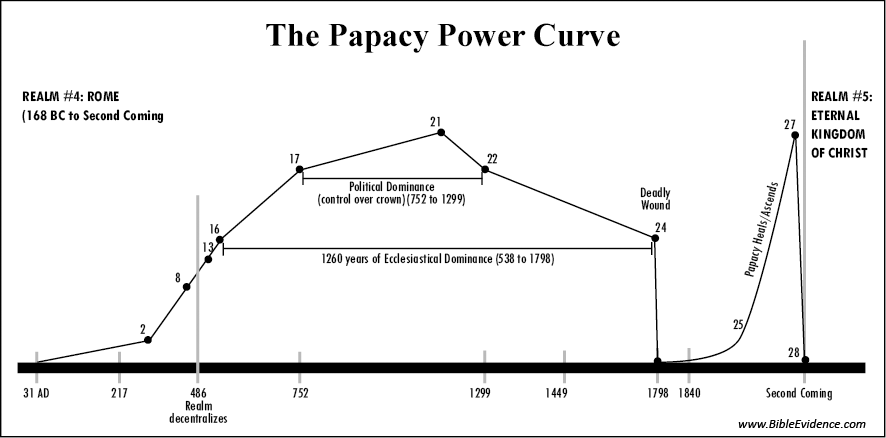
The Papacy Power Curve
Back to the Daniel 7 Study Guide.The Papacy fulfills a number of prophecies in Daniel and Revelation. The list below provides some of the major events in the history of the Papacy. The reference numbers on the chart correspond to an item on the list.

| Ref | Date | Event |
|---|---|---|
| 1 | 195 AD | Victor I, the Bishop of Rome, attempted to exercise Roman authority over other churches. |
| 2 | 312 AD | Emperor Constantine was converted to Christianity at the Battle of Milvian Bridge and became a great promotor of Christianity, which became more and more popular in the Roman Empire during his reign (306-337 AD). |
| 3 | 313 AD | The Edict of Milan granted religious liberty to Christians. The emperors Constantine and Licinius met in Milan and agreed to treat Christians benevolently, resulting in the restoration of confiscated property and letting up of persecution. |
| 4 | 325 AD | The Council of Nicaea confirmed and clarified key church doctrines, especially differentiating Nicene Christianity from other forms of Christianity, such as Arian. |
| 5 | 366 - 384 AD | Roman church leader, Damasus, made the first clear claim to Peter as the foundation of his office.1 |
| 6 | 380 AD | Emperor Theodosius declared Nicene Christianity as the official state religion. |
| 7 | 410 AD | The city of Rome was sacked by the Arian Visigoths, led by Alaric I, leaving the bishop of Rome to fill the vacuum of leadership. |
| 8 | 455 AD | The Vandals attacked Rome, but Leo, the Bishop of Rome, persuaded their leader, Gaiseric, not to burn the city or murder the citizens, and these negotiations gave the pope power and prestige to grow into a leadership role. |
| 8B | 476 AD | The Arian German commander, Odoacer, deposed the last Roman Emperor, Romulus Augustus, further benefitting the papacy's position of leadership. |
| 9 | 486 AD | Clovis, King of the Franks, defeated the last Roman military commander in the west (the real power behind emperors), leaving the Roman Empire as a divided realm without central rule. |
| 10 | 493 AD | The Heruli, an Arian Christian kingdom, were defeated by the armies of Ostrogoth king Theodoric, whose campaign was funded by the eastern emperor Justinian. |
| 11 | 496 AD | Clovis, King of the Franks, was converted to Nicene Christianity. |
| 12 | 507-508 AD | The Franks defeated the Arian Visigoths. |
| 13 | 508 AD | Clovis was recognized as the first Christian (Nicene) King, receiving legal sanction from eastern Emperor Anastasius, and began to integrate the church into the heirarchical administration of his government. |
| 14 | 533 AD | The Eastern emperor declared the Pope in Rome spiritual head of all the churches. |
| 15 | 534 AD | The Arian Vandals were defeated by the armies of the eastern emperor Justinian. |
| 16 | 538 AD | The Arian Ostrogoths, attacked by the armies of eastern emperor Justinian, finally withdrew from Rome, freeing the papacy to rule themselves and exercise ecclesiastical supremacy over others according to the decree of 533 AD. |
| 16B | 554 | The eastern empire defeated the Ostrogoths and Franks and emperor Justinian issued the Pragmatic Sanction, which enabled his edicts to be enforced in Italy and incoporated the papacy into the framework of government. |
| 17 | 752 | The Pope crowned the King of France, providing legitimacy to a political ruler of a Christian kingdom and setting a precendent to continue for hundreds of years of political dominance of the papacy. |
| 18 | 1076 | Pope Gregory VII humiliated Holy Roman emperor Henry IV and demonstrated the supremacy of the church. |
| 19 | 1095 | Pope Urban II launched the Crusades. |
| 20 | 1199 | Pope Innocent III (1198 - 1216) claimed to be the sole "vicar of Christ." |
| 21 | 1213 | Height of papal power under Innocent III. |
| 22 | 1299 | The papacy pushed princes and kings too far under Boniface VII and lost political dominance as the Council of Electors and conciliarism arose. |
| 23 | 1309 | The papacy was moved to France until 1377. |
| 23B | 1449 | The end of the unsuccessful Council of Basel increased the power of the popes over church councils, and the power of kings over princes and government councils. |
| 24 | 1798 | During the French Revolution, Napoleon's armies took the pope prisoner and the papacy was considered at an end (deadly wound), ending its 1260 years of ecclesiastical dominance in the realm. |
| 25 | 1929 | The Lateran Treaty recognized the Vatican as an independent state. |
| 26 | ? | The papacy's wound is healed as the papacy becomes ecclesiastically dominant again (Protestant churches give homage to the papacy by honoring the institutions that rest solely on the authority of the Roman Church and contradict the Bible). |
| 27 | ? | The divided nations of the Roman realm (10 horns) give power to the papacy as it becomes politically dominant again (8th Head). |
| 28 | ? | The papacy, along with all earthly powers, encounter disaster during the 7 Last Plagues. |
How to calculate the 1260 Years (538 - 1798 AD)
The Little Horn fulfilled by the Papacy
- 1. David J. Stagaman, Authority in the Church, page 87.
